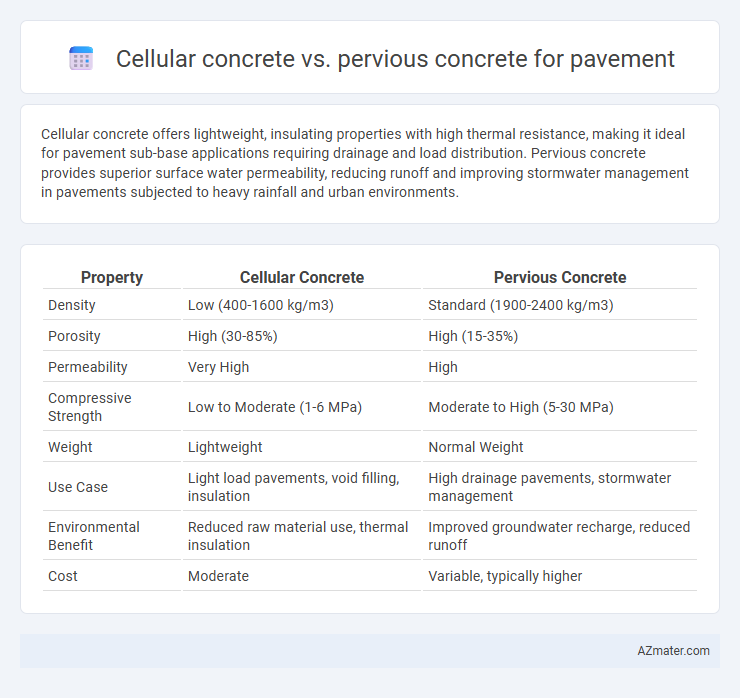Cellular concrete offers lightweight, insulating properties with high thermal resistance, making it ideal for pavement sub-base applications requiring drainage and load distribution. Pervious concrete provides superior surface water permeability, reducing runoff and improving stormwater management in pavements subjected to heavy rainfall and urban environments.
Table of Comparison
| Property | Cellular Concrete | Pervious Concrete |
|---|---|---|
| Density | Low (400-1600 kg/m3) | Standard (1900-2400 kg/m3) |
| Porosity | High (30-85%) | High (15-35%) |
| Permeability | Very High | High |
| Compressive Strength | Low to Moderate (1-6 MPa) | Moderate to High (5-30 MPa) |
| Weight | Lightweight | Normal Weight |
| Use Case | Light load pavements, void filling, insulation | High drainage pavements, stormwater management |
| Environmental Benefit | Reduced raw material use, thermal insulation | Improved groundwater recharge, reduced runoff |
| Cost | Moderate | Variable, typically higher |
Introduction to Cellular Concrete and Pervious Concrete
Cellular concrete is a lightweight, foam-filled material characterized by its low density and high insulative properties, making it suitable for reducing the load on underlying pavement layers and improving thermal performance. Pervious concrete, also known as porous or permeable concrete, features interconnected voids that facilitate water infiltration, reducing surface runoff and promoting groundwater recharge in pavement applications. Both materials offer unique advantages in pavement design, with cellular concrete enhancing structural efficiency and pervious concrete supporting sustainable drainage solutions.
Composition and Material Properties Comparison
Cellular concrete is composed of cement, water, fine aggregates, and a pre-formed foam, resulting in a lightweight, low-density material with high thermal insulation and reduced compressive strength. Pervious concrete consists of a mixture of cement, coarse aggregates, and minimal fine aggregates, designed to create a highly porous structure that allows water infiltration while maintaining sufficient strength for pavement applications. The key material property difference lies in cellular concrete's closed-cell structure providing better insulation but lower load-bearing capacity, whereas pervious concrete's interconnected voids optimize permeability and durability for managing stormwater.
Structural Performance in Pavement Applications
Cellular concrete exhibits lower compressive strength compared to pervious concrete, making it less suitable for high-load pavement applications but advantageous for lightweight subbase layers and void-filling. Pervious concrete offers superior structural performance due to its higher mechanical strength and permeability, enabling effective water drainage while supporting vehicular loads in pavement systems. Both materials contribute to sustainable pavement design, with pervious concrete providing enhanced durability and structural integrity under repeated traffic stress.
Permeability and Drainage Capabilities
Cellular concrete exhibits moderate permeability due to its air-entrained structure, allowing some water passage but with limited drainage efficiency compared to pervious concrete. Pervious concrete is specifically designed with a highly porous matrix that enables rapid water infiltration and superior drainage capabilities, reducing surface runoff and improving pavement sustainability. This enhanced permeability makes pervious concrete ideal for stormwater management applications, whereas cellular concrete is better suited for lightweight structural uses with moderate drainage needs.
Thermal and Acoustic Insulation Characteristics
Cellular concrete offers superior thermal insulation due to its air-entrained, lightweight structure, which reduces heat transfer in pavement applications. Pervious concrete, while promoting water drainage through its porous matrix, provides limited thermal insulation and acoustic dampening properties compared to cellular concrete. The inherent voids in cellular concrete also contribute to better sound absorption, making it more effective for reducing noise pollution on pavements.
Installation Methods and Construction Efficiency
Cellular concrete offers rapid installation with its lightweight, flowable nature allowing for easy pumping and placement in complex pavement subgrades, reducing labor intensity and minimizing equipment needs. Pervious concrete requires careful mixing, placement, and compaction to maintain porosity and strength, which can increase installation time and demand skilled labor to avoid clogging and ensure permeability. Construction efficiency favors cellular concrete in drainage and void-filling applications, while pervious concrete excels in permeable pavement surfaces that balance water management with load-bearing capacity.
Environmental Impact and Sustainability
Cellular concrete offers superior insulation and reduced material consumption, leading to lower carbon emissions during production compared to pervious concrete, which excels in stormwater management by facilitating groundwater recharge and reducing runoff pollution. Pervious concrete enhances urban sustainability by mitigating flood risks and improving water quality through effective permeability, while cellular concrete contributes to environmental sustainability by using lightweight foamed cement that reduces raw material demand. Both materials promote eco-friendly pavement solutions, yet cellular concrete is ideal for insulating subgrades and reducing heat islands, whereas pervious concrete prioritizes hydrological benefits and urban water cycle restoration.
Cost Analysis and Economic Viability
Cellular concrete offers lower material and installation costs compared to pervious concrete due to its lightweight composition and easier handling, reducing labor expenses in pavement projects. Despite pervious concrete's superior drainage capabilities, its higher cement content and maintenance requirements increase overall lifecycle costs, impacting economic viability. For budget-sensitive pavement applications, cellular concrete provides a cost-effective solution with competitive performance, enhancing project affordability without compromising durability.
Typical Applications and Use Cases
Cellular concrete is commonly used for pavement sub-base stabilization, void filling, and lightweight backfill due to its low density and high flowability, ideal for reducing soil settlement and improving load distribution. Pervious concrete is primarily utilized in pavement applications requiring enhanced stormwater management and drainage, such as parking lots, pedestrian walkways, and low-traffic roads, facilitating groundwater recharge and reducing runoff. Both concretes serve distinct roles: cellular concrete excels in structural support and soil improvement, while pervious concrete focuses on permeability and environmental sustainability.
Pros, Cons, and Final Recommendations
Cellular concrete offers lightweight properties, excellent thermal insulation, and ease of installation, but it tends to have lower compressive strength and durability compared to traditional materials. Pervious concrete excels in stormwater management by allowing water infiltration, reducing runoff, and enhancing groundwater recharge, though it may suffer from clogging issues and reduced structural integrity under heavy traffic loads. For pavement applications requiring permeability and environmental benefits, pervious concrete is recommended, while cellular concrete is better suited for low-load, insulating pavement layers where weight reduction is critical.

Infographic: Cellular concrete vs Pervious concrete for Pavement
 azmater.com
azmater.com